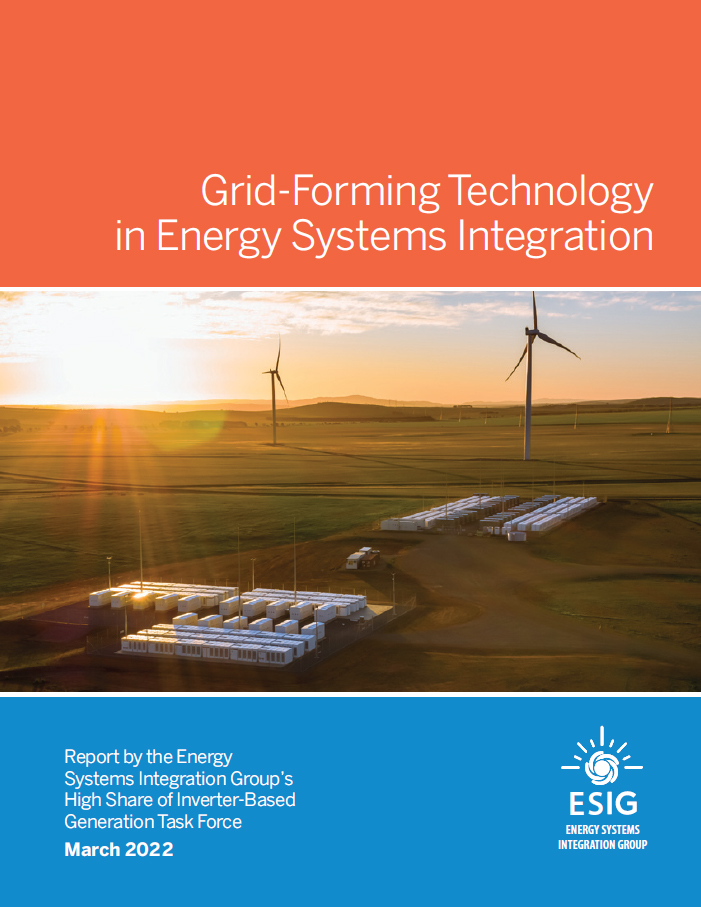A Process Aimed at Defining Technical Specifications that Meets the Needs of System Operators, Manufacturers, and Equipment Owners
Reston, Va. – The Energy Systems Integration Group (ESIG) has released a new report, Grid-Forming Technology in Energy Systems Integration, providing a comprehensive view of advanced inverter controls needed to run stable power systems with high shares of renewable energy.
 To maintain grid stability and reliability in power systems with increasing numbers of inverter-based resources (IBRs), some IBRs will need to have new functionality to enable them to provide system services that were previously provided by traditional synchronous generators. As IBR levels rise, new advanced inverter controls—termed grid-forming (GFM)—will be needed to maintain system stability.
To maintain grid stability and reliability in power systems with increasing numbers of inverter-based resources (IBRs), some IBRs will need to have new functionality to enable them to provide system services that were previously provided by traditional synchronous generators. As IBR levels rise, new advanced inverter controls—termed grid-forming (GFM)—will be needed to maintain system stability.
However, system operators, equipment owners, and manufacturers face a chicken-and-egg problem regarding the deployment of advanced IBR controls: which comes first, the requirement for a capability or the capability itself? How do grid operators know what performance or capability is possible from new equipment, and therefore what they could conceivably require? How can they evaluate costs and benefits of having such equipment on the grid? What drives manufacturers to invest in new technology without its being mandated for interconnection to the grid or otherwise incentivized by the market?
“Power systems today are undergoing a rapid transformation as the traditional fleet of thermal generation based on synchronous machines is being replaced by wind, solar, and battery power plants,” said Charlie Smith, executive director of the Energy Systems Integration Group. “This level of transformation is unprecedented and will require a transition in the provision of important system services from the thermal generation fleet to the fleet of IBRs. We are at a truly historic crossroads in the industry.”
“System operators and planners, equipment owners, and manufacturers face a ‘chicken-and-egg’ problem regarding the deployment of advanced IBR controls. Which comes first, the requirement for a capability or the capability itself,” said Julia Matevosyan, ESIG Chief Engineer and task force chair. “The report draws attention to the fact that, unless the chicken-and-egg cycle is broken, a large number of battery storage plants in interconnection queues will be built without advanced controls. This would then increase systems’ needs for additional reliability support from other sources. However, with clear technical requirements and market mechanisms providing incentives, a significant proportion of these battery storage resources could be equipped with grid-forming functionality, allowing them to actively contribute to system stability under high levels of renewables.”
Grid-Forming Technology in Energy Systems Integration presents a nine-step approach to breaking the chicken-and-egg cycle, starting from the perspective of evolving system needs. It explores the types of engineering and economic studies required to define and deploy new system services, and discusses the evolution of stability, analytical, and economic tools necessary to ensure stable power systems with high levels of renewables.
The Energy Systems Integration Group is a nonprofit organization that marshals the expertise of the electricity industry’s technical community to support grid transformation and energy systems integration and operation, particularly with respect to clean energy.
Click here to download the full report.
For more information on ESIG, visit www.esig.energy.
###

Leave a Reply